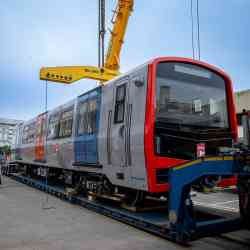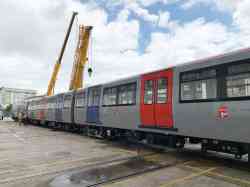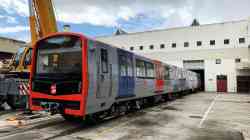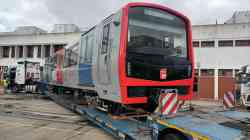Kronika
| 20.05.2025 |
Following the conclusion of roadworks on Calçada da Estrela, tram line 28E resumes its standard route from Martim Moniz ⇄ Campo de Ourique (Prazeres). However, between 07:00 and after 21:00, the service is limited to the segment from Graça ⇄ Campo de Ourique (Prazeres), with no operations between Graça and Martim Moniz. |
| 16.05.2025 |
Trams have returned to Rua da Prata.
15E — Resumes regular route Algés ⇄ Praça da Figueira. 15E bus shuttle Praça da Figueira ⇄ Alcântara is cancelled.
25E — Returns to previously extended route Campo de Ourique (Prazeres) ⇄ Praça da Figueira, but continues to use detour over Avenida 24 de Julho.
18E — Shortened to regular route Ajuda ⇄ Cais do Sodré |
| 17.04.2025 |
Second trainset of ML20 (M-804 + R-805 + M-806) has been delivered to Lisbon. |
| 02.04.2025 |
New line — 16E has been announced between Praça do Comércio and Parque Tejo at the eastern end of the city. The new line will stretch 12km of length, 18 stops a total cost of 160M€ (including new trams) and is estimated to begin operation by 2028. More info. |
| 17.02.2025 |
The temporary terminal of tram 25E due to construction works on Rua da Prata, has been changed from Cais do Sodré to Corpo Santo.
Even though this is the original terminal of 25E the trams have not returned to the original route as the tram tracks are still interrupted on Largo Vitorino Damásio due to the metro construction works. |
| Zobrazit celou kroniku |
Hledání foto podle linky
Tramvajové provozovny
| • |
Companhia Carris de Ferro de Lisboa, E.M., S.A. · Carris
Founded 08.11.1872.

Tram, funicular and bus operator with more than 150 years of history. The existing tram network reaches into the municipality of Oeiras to the west. |
Seznam typů
Nefotografovaná vozidla |
| • |
Carristur - Inovação em Transportes Urbanos e Regionais, Sociedade Unipessoal, Lda. · Carris
Founded 27.06.1985.
 | |  | | 
A division of Carris that offers tourist bus and tram services in collaboration with Yellow Bus. |
Seznam typů
Nefotografovaná vozidla |
| M |
Museu da Carris · Carris
Founded 12.01.1999.
 | | 
Lisbon's Museum of Public Transport History showcases a collection of vintage trams and buses. |
Seznam typů
Nefotografovaná vozidla |
| × |
Elevador da Estrela · NCAML (1882-1926)
1890 — 1913
One of the three cable tram routes in Lisbon. Operated by NCAML — Nova Companhia dos Ascensores Mecânicos de Lisboa, S.A.R.L., until 1913. It was integrated into the Carris tram network in 1915 and is currently part of tram route 28E. |
Seznam typů
Nefotografovaná vozidla |
| × |
Elevador da Graça · NCAML (1882-1926)
1893 — 1909
One of the three cable tram routes in Lisbon. Operated by NCAML — Nova Companhia dos Ascensores Mecânicos de Lisboa, S.A.R.L., until 1909. It was integrated into the Carris tram network in 1915 and and a portion of this route is now included in tram route 12E. |
Seznam typů
Nefotografovaná vozidla |
| × |
Elevador de São Sebastião
1899 — 1901
One of the three cable tram routes in Lisbon. Managed by Companhia Urbana de Viação a Vapor, was in operation from 1899 to 1901. It has since been entirely dismantled, leaving no traces behind. |
Seznam typů
Nefotografovaná vozidla |
| V |
Private collection of Paulo Marques
Trams from the private collections of Paulo Marques, P. Barreto, P. Franco, R. Fernandes, P. Mendes, and P. Costa. Information and images shared with the owners' permission. |
Seznam typů
Nefotografovaná vozidla |
| V |
Various municipality councils in Portugal
Old trams from Lisbon, owned by different municipalities across Portugal, are typically displayed as monuments. |
Seznam typů
Nefotografovaná vozidla |
|
Přehled vozového parku ve městě |
Seznam typů
Nefotografovaná vozidla |
Provozovny metra
Provozovny lanovky
| • |
Ascensor da Glória · Carris · NCAML (1882-1926)
In service since 24.10.1885.

Operated by NCAML — Nova Companhia dos Ascensores Mecânicos de Lisboa, S.A.R.L. until 1926, when it was acquired by Carris. It is now part of Lisbon's public transportation system, operating on route number 51E.
In 2002, it was designated as a National Monument. |
Seznam typů
Nefotografovaná vozidla |
| • |
Ascensor do Lavra · Carris · NCAML (1882-1926)
In service since 19.04.1884.

Operated by NCAML — Nova Companhia dos Ascensores Mecânicos de Lisboa, S.A.R.L. until 1926, when it was acquired by Carris. It is now part of Lisbon's public transportation system, operating on route number 52E.
In 2002, it was designated as a National Monument. |
Seznam typů
Nefotografovaná vozidla |
| • |
Ascensor da Bica · Carris · NCAML (1882-1926)
In service since 28.06.1892.

Operated by NCAML — Nova Companhia dos Ascensores Mecânicos de Lisboa, S.A.R.L. until 1926, when it was acquired by Carris. It is now part of Lisbon's public transportation system, operating on route number 53E.
In 2002, it was designated as a National Monument. |
Seznam typů
Nefotografovaná vozidla |
|
Přehled vozového parku ve městě |
Seznam typů
Nefotografovaná vozidla |
Provozovny elektrobusů
| • |
Companhia Carris de Ferro de Lisboa, E.M., S.A. · Carris
Founded 08.11.1872.

Tram, funicular and bus operator with more than 150 years of history. The bus network expands to include the neighboring municipalities of Amadora, Loures, Odivelas, Oeiras, and even Almada, located on the south bank of the Tagus River. All routes can be operated by both regular and electric buses, with no distinct routes exclusively for electric buses. |
Seznam typů
Nefotografovaná vozidla |
| • |
Rodoviária de Lisboa, S.A. · Carris Metropolitana
Established on 12.05.1995, and integrated into the Carris Metropolitana network as of 01.04.2022. It is a part of the Barraqueiro group.
 | | 
The operator of both regular and electric buses serves the municipalities of Loures, Mafra, Odivelas and Vila Franca de Xira, while also offering routes to Lisbon.
Since April 2022, it has held the concession rights to operate within the Carris Metropolitana network for these municipalities, covering area 2 of the network and managing the lines designated as 2xxx. |
Seznam typů
Nefotografovaná vozidla |
| V |
Viação Alvorada, Lda. · Carris Metropolitana
Established on 13.10.2020, and integrated into the Carris Metropolitana network as of 01.04.2022.
 | | 
The operator of both regular and electric buses serves the municipalities of Amadora, Cascais, Oeiras, and Sintra, while also offering routes to Lisbon.
Since April 2022, it has held the concession rights to operate within the Carris Metropolitana network for these municipalities, covering area 1 of the network and managing the lines designated as 1xxx.
Rolling stock listed in Oeiras. |
Seznam typů
Nefotografovaná vozidla |
| V |
Alsa Todi Metropolitana de Lisboa, Lda. · Carris Metropolitana
Established on 05.11.2020, and integrated into the Carris Metropolitana network as of 01.04.2022.
 | | 
The operator of both regular and electric buses serves the municipalities of Alcochete, Moita, Montijo, Palmela, and Setubal, while also offering routes to Almada, Barreiro, Lisbon, Seixal and Sesimbra.
Since April 2022, it has held the concession rights to operate within the Carris Metropolitana network for these municipalities, covering area 4 of the network and managing the lines designated as 4xxx.
Rolling stock listed in Setubal. |
Seznam typů
Nefotografovaná vozidla |
|
Přehled vozového parku ve městě |
Seznam typů
Nefotografovaná vozidla |
Maps
City Photo Galleries
Events
Exibitions
Rapid Transit
Funiculars
Nové fotografie
» Tram — Miscellaneous photos
» Postage stamps
» Metro — Miscellaneous photos
» Postage stamps
» Metro — M-801, M-804, M-806, R-805.
Informace
|
Information about municipality
|
|---|


|
Lisbon
First settlement: ~1200BCE
Roman city: ~138BCE
Area: 100,05km2 city / 3`015,24km2 metropolitan area
Lisbon, the capital and largest city of Portugal, is positioned on the western coast of the Iberian Peninsula at the confluence of the Tagus River and the Atlantic Ocean. It is part of the Lisbon Metropolitan Area and functions as the nation's political, economic, and cultural hub
The city features a comprehensive public transportation system that encompasses buses, trams, metro, and trains. The Lisbon Metro provides a quick and effective means of navigating the city, consisting of four distinct color-coded lines. Historic trams, particularly the famous Tram 28, offer picturesque journeys through the city's steep and narrow streets. Furthermore, suburban rail services link Lisbon to nearby regions such as Sintra, Cascais, and Setubal, facilitating easy commuting and regional travel. Ferries traversing the Tagus River and an expanding network of bike and scooter lanes further enhance the city's transportation options.
Lisbon is made up of 24 parishes, which include Ajuda, Alcântara, Alvalade, Areeiro, Arroios, Avenidas Novas, Beato, Belém, Benfica, Campo de Ourique, Campolide, Carnide, Estrela, Lumiar, Marvila, Misericórdia, Olivais, Parque das Nações, Penha de França, Santa Clara, Santa Maria Maior, Santo António, São Domingos de Benfica, and São Vicente.
|
|
Tram
|
|---|

Carris
(Companhia Carris de Ferro de Lisboa, E.M., S.A.)
Founded September 18, 1872
www.carris.pt

Museu da Carris
Founded January 12th, 1999
museu.carris.pt

Carristur
Founded June 27th, 1985
www.carristur.pt
|
System data
Length: 31km (in 2023), 76km (peak in 1958)
Number of lines: 6 (in 2023), 27 (peak in 1958)
Track gauge: 900mm (1435mm before 1888)
Electrification: 600 V DC overhead wire with poles and pantograph (only on line 15E)
History
The first horse-drawn tramcars commenced revenue service on November 17, 1873. The original track gauge was 1435mm, which was modified to 900mm in 1888, a measurement still in use today.
The electrification of the tram system started in 1901, leading to the cessation of horsecar services by 1902.
The tram network expanded until 1959, reaching its peak with 27 routes covering a total of 76 km.
However, the network began to decline with the introduction and expansion of the Lisbon Metro system, resulting in route closures and track removals. Many streets in Lisbon still feature unusable tram tracks, some partially covered by asphalt, disconnected from the network, or lacking overhead wires.
Since 2016, there has been renewed hope for the tram network's expansion, with route 24E reopening in 2018. Although it was initially announced to operate between Campolide and Cais do Sodré, it actually connects Campolide and Praça Luís de Camões.
Projects and constructions
In April 2025 an extension of the tram network towards east was announced with the new 16E route enabling a light rail similar connection from Terreiro do Paço to Parque das Nações.
Museum
On January 12th, 1999, Carris inaugurated the Museu da Carris at the Estação Santo Amaro, the last operational tram depot in Lisbon. The museum showcases the company's over 150-year history, featuring restored trams and buses, some of which are used in various parades throughout the year.
Tourist trams
Carris has launched a division named CarrisTur to offer transportation services along various tourist routes in the city using buses and trams, in partnership with Yellow Bus. The trams utilized for this purpose have been refurbished to reflect the design from the 1930s, but they now feature a red color scheme instead of the original yellow that is still employed by Carris's regular trams.
|
|
Tram routes
|
|---|
| Route nr. | Route | Notes |
|---|
| 12E | Martim Moniz → Rua dos Lagares → (← Graça ←) Largo das Portas do Sol ⇄ Rua Vitor Cordon ⇄ Praça Luís de Camões | The route has been altered because of construction on Rua da Prata. Although the roadwork on Rua da Prata is expected to finish in November 2023, the 12E bus has not resumed its original clockwise loop route. |
| 15E | Praça da Figueira ⇄ Praça do Comércio ⇄ Cais do Sodré ⇄ Alcântara ⇄ Mosteiro Jerónimos ⇄ Algés (Jardim) | The inaugural electric tram line in Lisbon from 1901, currently primarily operated by Siemens-Lisboa and CAF Urbos 100 trams, has its terminus at Algés (Jardim), situated in the adjacent municipality of Oeiras. |
| 18E | Cais do Sodré ⇄ Alcântara ⇄ Cemitério da Ajuda | |
| 24E | Campolide ⇄ Rato ⇄ Praça Luís de Camões | |
| 25E | Praça da Figueira ⇄ Avenida 24 de Julho ⇄ Estrela ⇄ Campo de Ourique (Prazeres) | Only on weekdays.
The route has been altered due to construction work associated with the metro expansion. |
| 28E | Martim Moniz ⇄ Graça ⇄ Largo das Portas do Sol ⇄ Rua Vitor Cordon ⇄ Praça Luís de Camões ⇄ Estrela ⇄ Campo de Ourique (Prazeres) | Route 28E is regarded as a tourist hotspot, with trams frequently filled to capacity with visitors rather than local commuters. |
| Hills Tram Tour | Praça do Comércio ⇄ Cais do Sodré ⇄ Estrela ⇄ Praça Luís de Camões ⇄ Largo das Portas do Sol ⇄ Graça ⇄ Martim Moniz Praça da Figueira ⇄ Praça do Comércio
(Circular, both ways) | This is exclusively a tourist route, not a standard service, and the pricing for the trip is different. |
|
|
Cable trams
|
|---|
NCAML
(Nova Companhia dos Ascensores Mecânicos de Lisboa)
Founded 1882, aquired by Carris in 1913
|
Of the three cable tram lines that once operated in Lisbon, two were constructed and owned by NCAML — Nova Companhia dos Ascensores Mecânicos de Lisboa, S.A.R.L.: the Elevador da Estrela and the Elevador da Graça. These lines shared similar propulsion systems, equipment, and rolling stock.
Both utilized a cable embedded in the public roadway between 900mm gauge rails, which was operated by stationary steam engines, while the cars themselves were engine-less.
By 1910 or shortly thereafter, the lines were not generating sufficient revenue to justify their maintenance, primarily due to the expanding Carris electric tram network. The Elevador da Graça ceased operations in 1909, while the Elevador da Estrela continued for an additional four years until 1913, when NCAML was acquired by Carris. Between 1913 and 1915, Carris renovated the lines and incorporated them into the electric tram system. The Elevador da Estrela, with minimal alterations to its route, remains part of tram route 28E. The Elevador da Graça underwent a slight modification, rerouting the upper end from Largo da Graça to São Tomé; this adjusted route is still served by Carris trams on route 12E, albeit in one direction only.
Additionally, NCAML constructed and owned three funicular lines, which were also acquired by Carris in 1913 and converted to electric power.
|
Companhia de Viação Funicular
Founded 1899(?), dissolved 1901(?)
|
The third cable tram line, Elevador de São Sebastião, operated by Companhia de Viação Funicular, had the briefest operational history. It was inaugurated in 1899 but ceased operations in 1901, likely due to an incident that resulted in a fatality.
It linked Largo de São Domingos, close to Praça Dom Pedro IV, with Largo de São Sebastião da Pedreira, situated near the present-day São Sebastião metro station, running parallel to Avenida da Liberdade.
In contrast to the other two cable tram lines, this one has no remnants visible today. Even the tram lines that operated on brief sections of this line have been removed.
|
|
Metro
|
|---|

Metropolitano de Lisboa
Founded January 26th, 1948
Service started December 29th, 1959
www.metrolisboa.pt
|
System data
Length: 44,5km
Number of lines: 4
Track gauge: 1435mm
Electrification: 750 V DC over third rail
Top speed: 60 km/h
History
The initial concepts and suggestions for a metro system in Lisbon were introduced and discussed in 1888, 1923, and 1924, but none of these initiatives received approval.
Following World War II, when Portugal maintained a neutral stance, the economic conditions were conducive to such an initiative. Consequently, on January 26th, 1948, a society was established to assess the technical and economic viability of implementing a metro system in Lisbon.
Construction commenced on August 7th, 1955, and the Lisbon Metro was officially opened four years later on December 29th, 1959. The network featured a Y-shaped line connecting Restauradores to Rotunda (currently known as Marquês de Pombal), with branches extending to Entre Campos and Sete Rios (now Jardim Zoológico), where the rolling stock depot (Parque de Material de Oficinas I, or just PMO I) was situated, also connected to the outer-loop Cintura Line of CP.
Approved expansion and constructions
In 2021, the expansion of the green line from Cais do Sodré to Rato commenced. This project will introduce two new stations, Santos and Estrela, facilitating a connection between the green and yellow lines and enabling a reconfiguration of the lines. The green line will transform into a circular route, assuming the current yellow line path between Rato and Campo Grande. The yellow line will take over the existing green line route from Campo Grande to Telheiras. This adjustment will pave the way for potential future expansion of the yellow line towards Benfica and Amadora, although this has not yet been approved.
In 2023, the extension of the red line from São Sebastião to Alcântara received approval. This expansion, which will extend to the western part of the city, will include four new stations: Campolide/Amoreiras, Campo de Ourique, Infante Santo, and Alcântara. The completion of this project is anticipated by 2026.
A new transit line has been authorized in the northern region of Lisbon, encompassing the municipalities of Odivelas and Loures. The Violet Line will not function as a traditional metro line; instead, it will serve as a light rail route featuring underground sections. This line will link Várzea de Loures in Loures to the metro station in Odivelas and extend to Beatriz Ângelo Hospital, creating a 'C' shaped route.
|
|
Metro lines
|
|---|
| Line logo | Line name
(color, official) | Line name
(logo) | Route | History |
|---|
 | Linha AzulBlue Line | Linha da Gaivota
Seagull Line | Reboleira ⇄ Santa Apolónia | 1959: Sete Rios (now Jardim Zoológico) – Restauradores
1988: Sete Rios (now Jardim Zoológico) – Colégio Militar/Luz
1997: Colégio Militar/Luz – Pontinha
1998: Restauradores - Baixa-Chiado (Blue and Green Lines split)
2004: Pontinha – Amadora Este
2007: Baixa-Chiado – Santa Apolónia
2016: Amadora Este – Reboleira |
 | Linha AmarelaYellow Line | Linha do Girassol
Sunflower Line | Odivelas ⇄ Rato | 1959: Entre Campos – Rotunda (now Marquês de Pombal)
1988: Entre Campos – Cidade Universitária
1993: Cidade Universitária – Campo Grande
1997: Rotunda (now Marquês de Pombal) – Rato
2004: Campo Grande – Odivelas |
 | Linha VerdeGreen Line | Linha da Caravela
Caravel Line | Telheiras ⇄ Cais do Sodré | 1963: Restauradores – Rossio
1966: Rossio - Anjos
1972: Anjos - Alvalade
1993: Alvalade – Campo Grande
1998: Rossio – Cais do Sodré
2002: Campo Grande – Telheiras |
 | Linha VermelhaRed Line | Linha do Oriente
Orient Line | Aeroporto ⇄ São Sebastião | 1998: Alameda – Oriente
2009: Alameda – São Sebastião
2012: Oriente – Aeroporto |
|
|
Funiculars and elevators
|
|---|
NCAML
(Nova Companhia dos Ascensores Mecânicos de Lisboa)
Founded 1882, aquired by Carris in 1913

Carris
(Companhia Carris de Ferro de Lisboa)
Founded September 18th, 1872
www.carris.pt
|
History
The history of Lisbon's funiculars is often linked to the three cable tram routes that ran in the city from 1890 to 1913. Unlike the cable tram routes, which were integrated into the expanding tram network and did not traverse steep inclines, the three funiculars were not easily incorporated and continue to operate independently to this day.
The inaugural funicular line, Ascensor Lavra, commenced operations in 1884, followed by Ascensor da Glória in 1885. The third funicular, Ascensor da Bica, was launched in 1892. Additionally, while not a true funicular, the Elevador de Santa Justa, which is classified as an elevator, began service in 1901.
The three funicular lines and the Santa Justa elevator were constructed and first managed by NCAML — Nova Companhia dos Ascensores Mecânicos de Lisboa, S.A.R.L., along with two of the three cable tram lines. In 1913, Carris acquired NCAML and assumed control of their operations.
Initially, all funicular lines and the decommissioned cable tram lines operated on steam power, except for the Ascensor da Glória, which originally utilized a water-powered counterweight before switching to steam power one year after its inauguration in 1886. Between 1914 and 1916, all funicular lines transitioned to electric power.
On February 19th, 2002, they were all designated as national monuments.
|
|
Funicular lines and elevators
|
|---|
| Route nr. | Name | Route | Length | Notes |
|---|
| 52E | Ascensor do Lavra | Largo da Anunciada ⇄ Rua Câmara Pestana | 188 m | In service since 1884
National Monument since 2002 |
| 51E | Ascensor da Glória | Restauradores ⇄ São Pedro de Alcântara | 265 m | In service since 1885
National Monument since 2002 |
| 53E | Ascensor da Bica | Rua de São Paulo ⇄ Calçada do Combro/Rua do Loreto | 283 m | In service since 1892
National Monument since 2002 |
| 54E | Elevador de Santa Justa | Rua de Santa Justa ⇄ Largo do Carmo | 0 m
(vertical elevator) | In service since 1901
National Monument since 2002 |
| - | Elevador do Chiado | Rua do Crucifixo ⇄ Rua Garrett | 0 m
(vertical elevator) | 1892-1912
Since 1913 integrated into Armazéns do Chiado shopping center |
| - | Elevador de São Julião ou do Município | Largo de São Julião ⇄ Largo da Biblioteca Pública
(now - Largo da Academia Nacional de Belas Arte) | 0 m
(vertical elevator) | 1897-1915
No remains |
|
|
Electric buses
|
|---|

Carris
(Companhia Carris de Ferro de Lisboa)
Founded September 18th, 1872
www.carris.pt
|
The Carris electric bus fleet operates on various bus routes throughout Lisbon, without any dedicated electric bus routes. However, the 'Bairro' routes, indicated by a 'B' following the route number, is mainly served by Karsan e-Jest electric minibuses.
|

Carris Metropolitana
Founded April 1st, 2022
www.carrismetropolitana.pt

Viação Alvorada
Founded October 13th, 2020

Rodoviária de Lisboa
Founded May 12th, 1995

Transportes Sul do Tejo
Founded January 25th, 1995

Alsa Todi
Founded November 5th, 2020
|
Four distinct operators have been granted concession rights to operate within the Carris Metropolitana network, delivering services across 19 municipalities in the Lisbon metropolitan area: Viação Alvorada (based in Oeiras), Rodoviária de Lisboa (based in Lisbon), Transportes Sul do Tejo (based in Almada), and Alsa Todi (based in Setubal). Transportes Sul do Tejo is the sole operator among the four that does not currently utilize electric buses in its fleet. Carris Metropolitana does not possess any rolling stock; instead, all services are operated by the four operators. Its role is to guarantee equitable service across the entire Lisbon metropolitan region.
The Carris Metropolitana network is divided into four areas, with Lisbon at the center, and each area is managed by a different operator:
- Area 1 - North-west (Amadora, Cascais, Oeiras, Sintra) serviced by Viação Alvorada based in Oeiras
- Area 2 - North-east (Loures, Mafra, Odivelas, Vila Franca de Xira) serviced by Rodoviária de Lisboa based in Lisbon
- Area 3 - South-west (Almada, Barreiro, Seixal, Sesimbra) serviced by Transportes Sul do Tejo based in Almada
- Area 4 - South-east (Alcochete, Barreiro, Moita, Montijo, Palmela, Seixal, Setubal) serviced by Alsa Todi based in Setubal
Carris Metropolitana route numbers consist of four digits, which serve to identify both the route type and the corresponding area:
- The first digit denotes the area, as previously mentioned.
- The second digit specifies the type of route:
- 0 through 4 indicates inter-municipal routes, each corresponding to a different municipality within the area;
- 5 indicates routes between adjacent municipalities;
- 6 indicates routes linking Barreiro or Cascais, where local bus services are still operational outside of Carris Metropolitana network;
- 7 and 8 indicates routes connecting to Lisbon;
- 9 indicates routes that exit the Lisbon metropolitan area.
- The final two digits represent the specific route number, which may sometimes refer to an older designation prior to the establishment of the Carris Metropolitana network.
|
|
|
Náhodné foto

     
|
 Elektrická Městská Doprava
Elektrická Městská Doprava





























 |
| 
 |
| 
 |
| 
 |
|  |
| 










